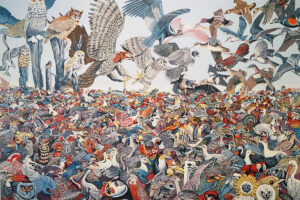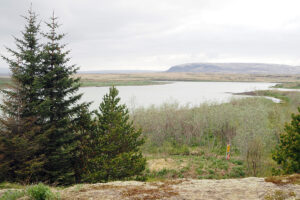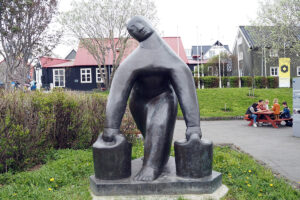Thursday, June 1
Icelandair DTW > KEF
Carla Harryman
The lonely imperative of travel, as if one is uniquely hailed. That is ideological, covered in pin feathers (illustration by Icelandic expatriate artist Eero above). It was an idea of mine to go north, to seek out the (scratch that). Over the long duration of our disease, the two survivors had lived on only home cooking and streaming Nordic crime series on Netflix. In the event, something was missing or being covered up—that is what is meant by “the body,” which kept us glued to our seats. The disused warehouse of narrative effects is where all bodies are kept, we would find, each waiting to be worked into the upcoming narrative. Not really—for years there had been a blank place in the narrative, now determined to be “magnetic north.” At some point in early winter it was decided, she suggested. Putting in place a plan, all would unfold but not necessarily the way it was predicted. I believe there is no drama here, only the outer shell of a fate that would be enacted, to be revealed. The crime genre is never really surprising, as we are gripped in our seats. The seats were booked on a newly refinanced Icelandair Boeing 737 Max, now returned to service, on a stopover in Iceland. The real thrill was seeming to go nowhere and ending up in a place we had imagined. Blank fields of lava unfold under the belly of the plane with special webcams for passengers. It will be early morning the next day when we arrive at our destination.
Friday, June 2
Hotel Grandi, Reykjavík
The day dawns early and ends late, if at all, this far north. Hence heavy curtains are required for guests in order to re-set their internal clocks. Having arrived is always a double process, catching up with oneself. The day awaits on a street leading into the center of town, about 1 km distant. There might be an agenda, for instance to begin one’s voyage of discovery at the National Library of Iceland, proximate to the university or HIS, another 1 km distant. At the corner of a broad boulevard, overlooking modern buildings, a statue commemorates dispossession and the hard life of the North. There is a baseline materialism at the core of any magnet, we would come to know.
The library reveals its deep holdings only on request but there are displays for the public. These are some of the core books one needs to comprehend Iceland: “Jónsbók was the name given to the first handwritten lawbook in Iceland. It was a compilation of the Icelandic laws that existed in around 1280 and was named after the author, Jón Einarsson, who was the ‘law speaker and who compiled the laws at the request of the Norwegian king.” Compiling the laws would make a record that may accede to a chronicle: see also the form of the saga. A hand-copied hymnal records the passion of its occasion, while the National Museum bookstore is well stocked with Icelandic sagas in multiple translations. Examples of the genre of stark black-and-white photography evidencing modern hardship and dispossession are also on display.
Icelandic history is a gigantic bookmark for “later” when it has in fact been in existence for over 1000 years. Gradually the concept of “settlement” emerges as primary fact of the landscape, insofar as we can know it—and from there it is only another millennium until Charles Olson worried over that primal occasion. I refer the reader also to Carl Ortwin Sauer’s In Northern Mists.
Benedikt Hjartarson
Johanna Hjartarson
Asgrimur Hjartarson
What is the moment of the “avant-garde” in the land of settlements? The negativity of nordic noir (scratch that). I had made contact with Benedikt Hjartarson, one of the founders of EAM (European Modernist and Avant-Garde Studies), whose activities and prompts extend throughout these pages. I suggested we meet and he kindly invited us to his family home for dinner. Somewhat outside the main part of Reykjavík, an area of substantial apartments and all-electric vehicles, a livable modernity based on nordic design. Iceland could easily achieve carbon neutrality with its resources of geothermal energy. This was a topic of conversation, as was the killing of whales that had recently been protested (Björk led a march in Reykjavík only days earlier). I asked if there was a Björk Studies emerging at the intersection of the avant-garde and popular culture, and found that there is. The future has arrived in Iceland, though there are barely 400,000 people to take part in it. Many have come from elsewhere, increasingly due to the Ministry of Finance’s business plan—to establish the throughput of a global hub. We spoke of the neoliberalism and corruption of an earlier government, which the present one means to correct. We spoke of Icelandic artists and writers, with a focus on Halldór Laxness. The magnetic north in his world-historical writings would unveil itself tomorrow. And of traveling to the islands of Vestmannaeyjar, whose name is derived from “West men,” or Irish monks, who came there is search of solitude. When the Vikings showed up a bit later, they decided to respect each others’ aims. What does it mean to “go West,” in migrations that only end in the liminal horizons of the outer sea?
Heidegger’s notion of the West as liminal destining is suspicious, but not nearly as bad as hearth or home. We spoke briefly of W.H. Auden and Louis MacNiece’s Letters from Iceland, wondering where to obtain a copy. The hospitality we were offered in our host’s hearth and home was likewise world-class, soon to be featured in a West-seeking book.
Saturday, June 3
Hertz Rental > Mosfellsbær
Having established “go West” as a motive force, we picked up a rental near the city airport and found our way, over suburban roads with gas stations and malls that open to the landscapes of central Iceland. This was a landscape that produced a Nobel Prize in the form of Halldór Laxness and his writings. Opposite the Laxness horse farm, where the author grew up, he built a modernist writing retreat and guest house as the result of his success that became a window on the world—to which he traveled and brought back things. Such things giving evidence of a “world” included African sculpture, South Asian tapestries, Nordic furniture, and Icelandic painting from whomever counted as “modern” at the time (Erró, Asger Jorn, Kristjan Davídsson, contemporary abstractionists) amounting to a period style of regional/universal value after the “blessed war” Iceland survived. Reading Laxness, for example
the novel World Light (1937–40), makes both landscape (world) and atmosphere (light) into a complex articulation of human settlement and displacement over 1000 years that is also “modern.” Laxness’s modernity takes the form of the house (named Gjlúfrasteinn, “derived from a large stone in the vicinity, about which Halldór wrote the short story ‘Steinninn minn helgi’ at the age of 19”). The house situated in a landscape becomes a book of the world. The house itself is a “site,” in a landscape dotted with sites—for instance, Thingvellir, up the road, the place of the annual convocation of chiefs on the faultline of the Atlantic Ocean ridge. A nascent parliamentary democracy emerged over those thousand years that assembled chiefs from the length of Iceland: “The longest journey a goði (chieftain) had to travel was 17 days, from the easternmost part of the country where mountains and glacial rivers proved bothersome obstacles.” One of those chiefs is Halldór Laxness himself, popular and photogenic, a student
of the American Left and the Cold War, “man of the world,” both interpreter and interpretant. This must be the purpose of all literature in a universal light, or so it seems by the evidence of Laxness’s life work as integral to the landscape.
Herjólfur (Ferry) > Vestmannaeyjar
One aspires to become such a site, but in the event we needed to move on toward our goal which is not one in a rental Toyota (tin can) with manual shift.The landscape opens out to ridges and distant ranges, planar expanses of larger and smaller lakes with scarcely any trees. At one of them is a dock with some weekend rentals, a restaurant with world-class fish soup at market prices, and tables of world travelers who avoid acknowledging each other. Such as the U.K. couple who seemed to be on a secretive spy mission, or the American family whose team spirit likely caused palpitations among the Brits. Departing from the mandated tour of the Golden Circle, we traversed ordinary working farms with sheep and cows, small herds of Iceland ponies, and steel bridges over muddy snow melt rivers.
Our goal was the 15:15 ferry to Vestmannaeyjar, across the broad terrain of Njal’s Saga to the town of Hvolsföllur (with a tourist center where virtual reality reenacts the severing of heads and limbs): “The saga deals with a process of blood feuds in the Icelandic Commonwealth, showing how the requirements of honor could lead to minor slights spiraling into destructive and prolonged bloodshed,” Wikipedia instructs. We did not stop for blood sports but were diverted by a singular waterfall coming off the back of Eyafjöll volcano being observed by international hundreds. Walking to a photogenic spot, the wind shifted and we were drenched in spray but left undeterred to our reservation for the ferry at Landeyjahöfen. The Vestmannaeyjar islands are a series of active and defunct volcanic cones, about as sublime or picturesque as one can wish (noting the difference in habitability and risk), reached over about 20 km of open sea (45 minutes).
On deck of the boat, I spoke with experts in marine biology on a field trip of several weeks and watched for puffins on the uninhabited cliffs. One of the islands, it is noted, has a single guest cabin rumored to have been used by Björk, who is the stuff of legend (soon to be annotated as part of Björk Studies). The town itself is home to 4000 people working, it appears, in fishing and tourism, which is being aggressively promoted in images that make the islands look like a nordic Tahiti. Their beauty is not only picturesque but modern: treeless, with warehouses, cottages, and weekend retreats exploring geometric relations and neutral tones that are visually dramatic when opposed to craggy volcanic calderas and reddish lava heaps.
After an exceptional meal of Icelandic cod shared at the local brewpub, we walked for hours until the return ferry, ping-ponging from one visual hit after another, under the unfading light. No puffins but a golf course under the crags. The late night return to Reykjavík was reminiscent of cross-country drives through Nevada or Wyoming until the tidy metropolis announced itself and we found parking in the twilight outside our hotel.
Sunday, June 4
Erró: The Power of Images
Reykjavík Art Museum, Hafnarhús
Kaleidoscope: Icelandic 20th Century Art
Reykjavík Art Museum, Kjarvalsstaðir
The map has unfolded, unpacked, spread out by the dogmatic insistence of three-dimensional versions of actual space. As Laura Riding wrote, paradoxically, “so small is space,” while she imagined a map shot through with holes to nowhere. But space is always as large as it is, and this is no less surprising in a small country like Iceland where there is a great deal of largeness in space. Reykjavík is a small city, the center of town generally walkable from one end to the next, where one can have a very expensive lunch and visit a number of museums. But this is an illusion: turning the corner of any street, space is as large as it usually is. The National Museum, it is true, is a repository of time
in a building that is easily traversable from one end to the next, spanning centuries. Every detail of the museum unfolds onto a space and time of its own. There is a kind of paradigm shift or conversion experience between epochs that is carefully charted as an effect of space—this is what the museum passes off as “history.” But these spaces are all around us, even if infected by those coming from elsewhere to be gone in a day. Like we were—only temporarily here in time and space. Thus, a careful planning of space becomes a mandated itinerary in time for anyone moving through such a town. Before we had even left our rooms, our itinerary had begun with the cheerful foreigners working their shifts and others posing as international guests.
We could not find the alternative art center Kling & Bang on the urbanizing pier, with carnival barkers and food courts, but it was in the same building as Olafur Eliasson’s studio. One of the two Reykjavík museums featured the graphic cartoon collage work of Erró, who had participated in the COBRA movement and gone on the international fame. One sensed a certain staff boredom with his dumpster diving image jamming, whatever postmodern juxtapositions he might achieve. Later, while one of us searched for a book he had in mind, one of us went home to rest. We could have gone farther up the coastline, which beckoned with a narrative of its own. But we chose to take things as they came: a museum, lunch at The Old Iceland, a second art museum with modern and regional art. This museum had many estimable works from the modern period of Icelandic self-reflection; I cite Hraunteigar by Mt. Hekla by Jon Stefánsson (1930) as a highpoint of Icelandic painting, paralleling Marsden Hartley’s New Mexico or Maine.
This quick scan of several decades of Icelandic art, mirroring many styles but often returning to landscape or atmosphere or the sea, was followed by a visit to the public pool, with its geothermal spa on a collective balcony. I for one admired the view of heads, bodies, breath, steam—of men and boys, women and girls. Most of them were Icelandic, spoke the language and were native to the place, but many other languages were heard as they were not. As we ourselves were (not). But I was still the same body in the unheated pool, counting laps, just as I was one body in the heated pool, head above water. Could we have managed further travel up the coast to Bogarnes, only 30 km distant or about one hour away? We would not have missed its Settlement Center, the traces of Egil’s Saga, its reputedly fine restaurant, or its geothermal pool. As it happened we ate out with aplomb and expense at Fiskfélagid (Fish Company) a few blocks down on Vesturgata, returned leisurely past multicolored buildings,
some remodeled some not, past the nonbinary wall mural that had greeted us on our arrival, now seen in a different light. It was with a feeling of having achieved at least one day’s residence, however packed, that we left Reykjavík, vowing soon to return.
Notes and links
Images: all photos (c) Barrett Watten 2023; reproduce by permission only.
Note: our travels took place in time frame of diminished COVID, but some decisions (such as whether to enter the geothermal pool) depended on its possible persistence.
For Norway, Watten/Viken and Utness families, Magnetic North II here.
For Oslo to Rügen Island, Magnetic North III here.
For entry into Berlin, Magnetic North IV here.
For last days in Berlin, Magnetic North V here.

















